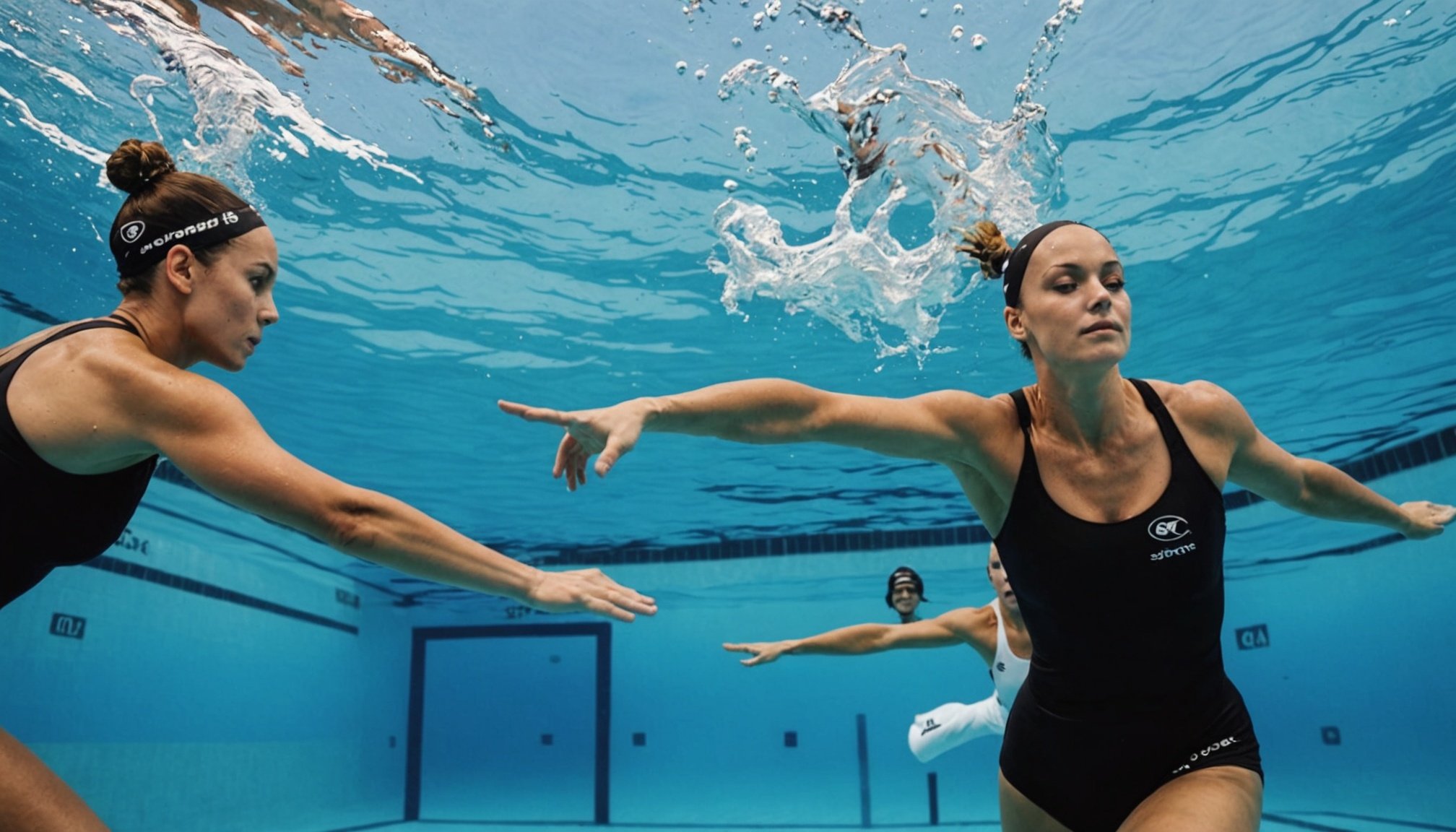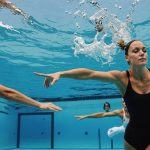Mastering Underwater Breath Control: Essential Tips for Synchronized Swimmers
Understanding the Importance of Breath Control in Synchronized Swimming
Synchronized swimming, often referred to as artistic swimming, is a highly demanding sport that requires a perfect blend of strength, flexibility, and breath control. One of the most critical aspects of this sport is the ability to control breathing underwater, which can make a significant difference in performance and safety.
“When you’re underwater, maintaining a regular and controlled breathing rhythm helps avoid panic and counteracts the constriction of blood vessels,” explains a seasoned synchronized swimmer. This technique is not just about holding your breath; it’s about managing your body’s physiological response to the cold water and the pressure of being submerged.
In the same genre : How Elevation Influences Biathlete Performance: Unpacking the Effects of Altitude
Breathing Techniques for Synchronized Swimmers
Diaphragmatic Breathing
Before diving into the water, practicing deep breathing exercises is crucial. This involves inhaling through the nose and exhaling slowly through the mouth, which helps to relax the diaphragm, calm the heart rate, and prepare the body for the temperature drop[1].
- Inhale deeply: Fill your lungs completely, feeling your diaphragm expand.
- Exhale slowly: Release the air slowly through your mouth, keeping your diaphragm relaxed.
- Repeat: Practice this cycle several times to calm your body and mind.
Bilateral Breathing
In synchronized swimming, bilateral breathing is essential for maintaining body position and control. This technique involves breathing on both sides, which helps in keeping the body straight and balanced.
Additional reading : Enhancing Strength and Flexibility in Competitive Archers: The Transformative Power of Yoga
- Alternate sides: Practice breathing on both your left and right sides during freestyle swimming.
- Body position: Ensure your body remains in a straight line from head to heels.
- Stroke adjustment: Adjust your stroke to accommodate bilateral breathing without disrupting your rhythm.
Training for Underwater Breath Control
Progressive Training
To master underwater breath control, progressive training is key. Here are some steps to follow:
- Start with short sessions: Begin with short immersions, especially if the water is very cold (below 15°C). Gradually increase the duration by 5-10 minutes per session[1].
- Regular practice: Swim regularly, ideally several times a week, to allow your body to adapt continuously.
- Monitor your body: Pay attention to signs like shivering, numbness, or loss of coordination, which indicate excessive cooling and require you to shorten the session.
Holding Exercises
Holding your breath is a critical component of synchronized swimming. Here are some exercises to improve your breath-holding capacity:
- Static Apnea: Hold your breath while standing or sitting. Start with short intervals and gradually increase the time.
- Dynamic Apnea: Swim underwater without breathing. Begin with short distances and increase them as you build endurance.
- Breath-Holding Drills: Practice holding your breath while performing simple movements underwater, like kicking your legs or moving your arms.
Breathing Techniques in Freediving and Their Application to Synchronized Swimming
Freediving, or apnea diving, involves holding your breath while diving underwater. The techniques used in freediving can be highly beneficial for synchronized swimmers.
Lung Capacity and Breath Control
Freedivers often practice exercises to increase their lung capacity, which can be beneficial for synchronized swimmers as well.
| Technique | Description | Benefit |
|---|---|---|
| Diaphragmatic Breathing | Breathing deeply using the diaphragm | Increases lung capacity and relaxes the body[3] |
| Yoga and Meditation | Practices that involve controlled breathing | Enhances breath control and reduces stress[5] |
| Swimming at Moderate Intensity | Long-duration swimming at moderate intensity | Improves aerobic capacity and increases oxygen storage[3] |
Managing Pressure and Equalization
In both freediving and synchronized swimming, managing pressure is crucial to avoid injuries.
- Equalization: Use techniques like the Valsalva maneuver or the Frenzel maneuver to equalize the pressure in your ears and mask during descent[3].
- Body Position: Maintain a streamlined body position to reduce drag and conserve energy.
Practical Insights and Actionable Advice
Breathing Swimming Drills
Here are some practical drills to improve your breathing technique while swimming:
- Bilateral Breathing Drill: Swim freestyle, breathing every two strokes on one side, then switch to the other side.
- Focus on body position: Keep your body straight and your head down.
- Adjust your stroke: Ensure your arm stroke is symmetrical and smooth.
- Underwater Kicking Drill: Kick your legs underwater while holding your breath.
- Focus on leg movement: Keep your legs relaxed and use a flutter kick.
- Monitor your breath: Practice holding your breath for longer intervals.
Mental Preparation
Breath control is as much a mental challenge as it is physical. Here are some tips for mental preparation:
- Relaxation Techniques: Use techniques like yoga or sophrology to calm your mind and body before swimming[5].
- Visualization: Visualize yourself performing the swim smoothly and efficiently.
- Positive Self-Talk: Encourage yourself with positive affirmations to stay focused and calm.
Real-Life Examples and Anecdotes
Many synchronized swimmers have shared their experiences and tips on mastering breath control.
“One of the most challenging aspects of synchronized swimming is the ability to hold your breath while performing complex routines,” says a synchronized swimmer. “I practice diaphragmatic breathing before every session, and it helps me stay calm and focused underwater.”
Another swimmer adds, “During competitions, I visualize myself performing the routine flawlessly, which helps me manage my breath and stay in control.”
Mastering underwater breath control is a journey that requires patience, practice, and dedication. By incorporating diaphragmatic breathing, bilateral breathing, and progressive training into your routine, you can significantly improve your performance and safety in the water.
As a synchronized swimmer, it’s essential to remember that breath control is not just about holding your breath; it’s about managing your body’s physiological response to the water and maintaining a calm and focused mind.
By following these tips and techniques, you can enhance your swimming breathing, improve your lung capacity, and achieve better overall performance in the pool. So, dive in, breathe deeply, and let your body and mind synchronize in perfect harmony.











